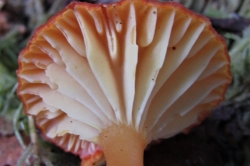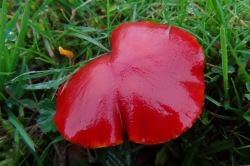A small red Waxcap that is fairly easy to identify as it has a scurfy cap unlike most other Waxcaps which have smooth, greasy caps. Being fairly rare and small this beautiful mushroom, although edible, is better to admire and photograph than to pick for any reason.
Home / Mushroom Guide /
Vermilion Waxcap
Vermilion Waxcap
| Mushroom Type | |
| Common Names | Vermilion Waxcap (EN), Cap Cwyr Fermiliwn (CY), Wilgotnica Purpurowa (PL), Apró Nedűgomba (HU) |
| Scientific Name | Hygrocybe miniata |
| Season Start | Sep |
| Season End | Dec |
| Average Mushroom height (CM) | 2-5 |
| Average Cap width (CM) | 1-5 |
Cap
1-5 cm. Has a dry, scurfy cap that starts red but fades to orange yellow with age. Can have an uneven to almost scalloped edge.
Gills
Pale yellow widely spaced gills which can have an orange or red hue. Broadly joined to the stem (adnate) with a small decurrent tooth.
Possible Confusion
Some of the other small red waxcaps like the Scarlet Waxcap (Hygrocybe coccinea), pictured, but these have greasy caps unlike the miniatas scurfy cap.
Spore Print
White, ellipsoid.
Taste / Smell
Mushroomy but this mushroom is very small and is best left in the ground.
Frequency
Uncommon.
Other Facts
Waxcaps don’t like to be disturbed or sprayed so will be found where fields and woodland have been left alone.
It is now thought that waxcaps grow in association with mosses, before it was thought that waxcaps were saprophytic living or decaying organic matter.


 (6 votes, average: 4.33 out of 5)
(6 votes, average: 4.33 out of 5)




























Leave a Reply